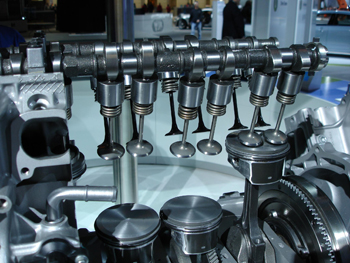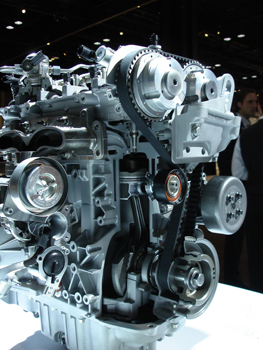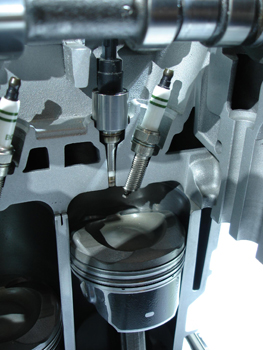 In recent years, the primary driving force behind engine innovation has been the never-ending quest for better fuel economy with little or no sacrifice in performance.
In recent years, the primary driving force behind engine innovation has been the never-ending quest for better fuel economy with little or no sacrifice in performance.
Government regulations and rising fuel prices are forcing automakers to develop new technologies and powertrains that squeeze more power out of every drop of fuel while producing less pollution and greenhouse gas (carbon dioxide) emissions.
It’s a given that in the years ahead, we will see more vehicle and engine downsizing, more vehicles with hybrid powertrains and more “clean diesel” powered cars and light trucks.
Last year, the average combined fuel economy for passenger cars and light trucks was 27.3 mpg, which is essentially the same as it has been for more than a decade. The actual breakdown was 30.2 mpg for cars and 24.1 mpg for light trucks. Since trucks and SUVs account for approximately half of all new vehicle sales, their lower fuel economy numbers drag down the overall average for the entire fleet.
New government-mandated fuel economy requirements will raise these numbers significantly over next few years. By 2016, the government wants passenger cars to achieve an average fuel economy of 39 mpg, and trucks 30 mpg, with a combined average of 35.5 mpg. Achieving this goal will save an estimated 1.8 billion barrels of oil and 900 million metric tons of greenhouse gas emissions.
How will the carmakers reach these targets? By downsizing vehicles, reducing vehicle size and weight and using smaller, more fuel-efficient powertrains.
Alternative Powertrains
Hybrids have been hot recently. The hybrid market has shown steady growth in recent years, with more than 100 hybrid models now available (including GM vehicles with the eAssist start-stop system). But the overall numbers are still relatively small, accounting for only about 2.5% of all new vehicle sales. Hybrid production has been very limited due to the high cost of the technology (an extra $3,000 per vehicle on average) and limited battery production capacity here and abroad.
In 2011, approximately half a million hybrid vehicles were sold in the U.S. By 2016, the sale of hybrid and plug-in electric vehicles (barring any further economic downturns) is expected to grow threefold to an estimated 1.5 million vehicles per year.
By comparison, the sale of new diesel-powered cars and light trucks is expected to skyrocket in the U.S., going from 680,000 in 2011, to more than 900,000 by the end of this year, to more than 9 million a year by 2016. In Europe, more than half of new car sales are currently diesels.
The explosive growth in the diesel market is being fueled by next generation Clean Diesel technology that delivers gasoline-like performance, driveability and performance with up to 30% better fuel
economy than today’s gasoline engines.
Rising Fuel Economy
Gasoline-powered internal combustion engines have undergone a long and progressive evolution since the early days of the automobile. The availability of higher octane leaded fuel back in the 1920s and 1930s allowed higher compression ratios for better fuel economy and performance. The next big innovation was the widespread use of overhead valve cylinder heads that were more efficient than the flathead designs of the early days.
Emission controls that were required in the late 1960s and early 1970s hindered performance and driveability in some instances, but allowed engines to run cleaner than ever before. Adding catalytic converters and electronic ignition systems in the mid-1970s reduced emissions even more. The biggest jump in performance, emissions and fuel economy came with electronic fuel injection (EFI) and electronic engine management systems in the 1980s.
Replacing high-friction flat tappet camshafts with roller cams reduced internal engine friction, along with lighter, thinner low-tension piston rings. Overhead camshafts and multi-valve combustion chambers with three, four or even five valves also improved engine breathing efficiency for better performance and economy.
Power Boost
Turbocharging and supercharging have also helped boost fuel economy by allowing smaller displacement four- and six-cylinder engines to develop power equivalent to a much larger displacement V8 engine. A turbocharger uses the hot exhaust gases that are exiting the engine to spin a high-speed turbine wheel.
The turbine wheel is connected by a short shaft to an impeller wheel that forces more air into the engine when extra power is needed. A supercharger, by comparison, uses a belt-driven compressor to add boost pressure. Superchargers develop more boost pressure at low engine speed for instant throttle response, while turbos develop their boost pressure at higher engine speeds.
Superchargers are used primarily on performance cars such as ZR1 Corvettes and Shelby GT500 Mustangs, though they have been used on the Chevy Cobalt and MINI Cooper S, too. Turbos are used across a broader spectrum of vehicle applications, including both gasoline and diesel engines.
 Ford’s 3.5L Eco-Boost V6 in its current Taurus SHO and F-150 truck develops 365 horsepower using a pair of turbos, yet delivers 25 mpg on the highway, which are far better numbers than a comparable V8. Ford’s Eco-Boost engines combine turbocharging with gasoline direct injection (GDI) to improve fuel economy up to 20% over that of a naturally aspirated engine with conventional EFI.
Ford’s 3.5L Eco-Boost V6 in its current Taurus SHO and F-150 truck develops 365 horsepower using a pair of turbos, yet delivers 25 mpg on the highway, which are far better numbers than a comparable V8. Ford’s Eco-Boost engines combine turbocharging with gasoline direct injection (GDI) to improve fuel economy up to 20% over that of a naturally aspirated engine with conventional EFI.
GDI improves fuel economy and performance by spraying fuel directly into the combustion chamber rather than into the intake port. Like a diesel engine, GDI requires very high-pressure injectors to overcome compression pressures in the engine. But it allows very precise control over fuel metering, vaporization and combustion for better fuel economy and lower emissions. Without turbocharging, the change to GDI
typically improves fuel economy 8-12% over a similar engine with conventional port fuel injection. Estimates are that one out of every five new cars produced next year will have GDI fuel systems.
Mazda’s new Skyactiv-G engines use advanced direct injection with a much higher than normal compression ratio (up to 13:1) to achieve impressive gains in both power and fuel economy. Their 2.0L Skyactiv-G engine gets 15% better fuel economy and produces 15% more torque and 15% fewer emissions than their previous 2.0L engine. When combined with their new six-speed automatic transmission, fuel efficiency is improved another 4-7%.
Adding more gears to automatic transmissions or using a continuously variable transmission helps improve powertrain efficiency and fuel economy, too. The latest Porsche Cayenne uses an eight-speed Tiptronic transmission. GM will also be using a new eight-speed automatic in next year’s Cadillac CTS, the next generation Camaro (due in 2015) and other vehicles.
Waste Not, Want Not
Cylinder deactivation or “displacement on demand” (DOD) is another trick some automakers are using on certain engines to boost low load fuel economy. Depending on the application, this can improve mileage 10-20%. GM has offered DOD since 2006 on certain vehicles, while Chrysler has had its “multiple displacement system” (MDS) since 2004 on some of its 5.7L Hemi engines in the Chrysler 300C, Dodge Magnum, Charger, Durango, Ram and Jeep Grand Cherokee and Commander. Honda’s version is called “variable cylinder management” (VCM), and is found on its Accord Hybrid and other V6 models.
On a GMC Sierra 1500 truck, for example, the 5.3L V8 engine with DOD operates in V4 mode with half of its cylinders deactivated when the engine is under light load. Specially designed valve lifters allow the lifters to collapse when solenoids reroute oil pressure during the deactivation mode. This prevents the lifters from pushing the valves open, isolating half of the engine’s cylinders.
The engine computer also shuts off the fuel injectors and ignition for the deactivated cylinders, too. The cylinder deactivation occurs in milliseconds, with almost no noticeable difference in the way the engine feels. When the throttle is opened and more power is needed, the engine seamlessly reverts back to its normal V8 mode of operation with all of the cylinders firing.
Cylinder deactivation should not be confused with “variable valve timing” (VVT), which has been around since the 1980s, and is commonly used on many late-model engines. VVT uses cam phasers on the ends of the camshaft(s) to either advance or retard the relative timing of the cams. A control solenoid changes how oil is routed into the cam phaser. Oil pressure moves a mechanism inside the cam phaser that allows the gear to slide a few degrees one way or the other to alter valve timing.
This, in turn, changes the opening and closing of the valves to earlier or later during the compression stroke and exhaust stroke to increase or decrease valve timing, duration and overlap. Increasing duration and overlap boosts high speed power while decreasing duration and overlap helps low end torque. This, VVT allows an engine to run more efficiently and develop more under a wider range of operating conditions than fixed camshaft timing.
Start-stop systems such as GM’s eAssist cut fuel consumption when a vehicle isn’t moving. Start-stop systems turn the engine off temporarily when the vehicle stops moving (as when sitting at a stop light). When the driver steps on the accelerator pedal, a belt-driven alternator functions as the starter and spins the engine back to life. Shutting the engine off, even for 10-20 seconds while stopped in traffic, can improve fuel economy 10-15% in city driving. But it does nothing to improve fuel economy when the vehicle is driven on the highway. Even so, for urban driving start-stop systems are appearing on more and more vehicles to reduce fuel consumption.
Down the Road
In the not-too-distant future, a number of new technologies will be applied to new production engines. One is the possible elimination of the starter motor entirely. With today’s sophisticated engine controls and sensors, it’s possible to start an engine by spraying fuel into a cylinder that is close to dead center on its compression stroke and then igniting the mixture. This starts the engine spinning without the need for a starter to crank it over.
 With direct injection, gasoline compression ratios will continue to approach those of diesel engines. Some say future engines may act like a conventional spark-ignited engine some of the time, and more like a diesel with compression ignition under different operating conditions. As the two technologies merge, it may be harder to tell what’s a diesel engine and what’s a gasoline engine.
With direct injection, gasoline compression ratios will continue to approach those of diesel engines. Some say future engines may act like a conventional spark-ignited engine some of the time, and more like a diesel with compression ignition under different operating conditions. As the two technologies merge, it may be harder to tell what’s a diesel engine and what’s a gasoline engine.
Smaller displacement engines with turbos will replace larger displacement naturally aspirated V8 and V6 engines to boost fuel economy. Future turbos may be driven by an electric motor rather than hot exhaust gases. An electric-powered turbo can spool up independent of engine speed or load to deliver instant boost. Getting rid of the exhaust-driven turbine wheel also gets rid of the heat, allowing the turbo to run much cooler and last much longer.
Variable valve timing may also be used to create unconventional compression and power strokes. These include an “Atkinson” compression cycle where the valves are opened later to create a longer power stroke, or a “Miller” cycle where the intake valves are opened longer than normal during the compression stroke. Both techniques improve breathing efficiency and power but require other tricks to make them work. High speed electric solenoids such as those used in some Formula 1 engines may eventually find their way into some production engines, eliminating conventional cams, lifters and rockers altogether.
Oddball engines such as the Mazda rotary Wankel engine won’t displace piston engines, but may live on with a next-generation design that uses no spark plugs. Ignition will be via small high-powered laser beams routed into the combustion chamber through a fiber optic cable.
Nobody sees impending doom for piston engines (gasoline or diesel) anytime soon. Though GM’s Chevy Volt uses a gasoline engine for extended-range driving, future plug-in electric vehicles will use no gasoline at all (like the current Tesla Roadster and Model S). Yet like today’s hybrids, their numbers will be extremely limited for many years to come due to the high cost, complexity and limited production capacity of electric powertrains and batteries.
Experimental fuel cell cars that make electricity from hydrogen have been running around test tracks and undergoing real-world evaluations for years. But carmakers are not jumping on the fuel cell bandwagon just yet because nobody can say for sure when this technology will be ready for mass production. Honda has been leasing a couple dozen of its FCX Clarity hydrogen-powered fuel cell vehicles since 2008, and Mercedes is leasing a few of its B-Class F-Cell hydrogen cars in southern California.
Chevrolet also has been running its “Project Driveway” fuel cell car evaluation program with a handful of fuel cell Equinox vehicles. Just keep in mind that these are very expensive test vehicles built to gather real-world driving experience and to promote a green image to the public. Large scale production of fuel cell vehicles is on nobody’s radar at this time, even if gasoline hits $5 a gallon or higher this summer.




